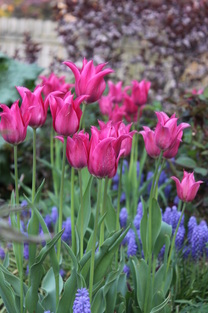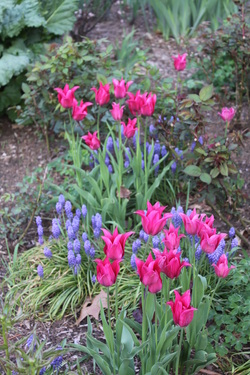 Muscari & Tulip 'Pretty Woman' Muscari & Tulip 'Pretty Woman' As Spring slowly but surely peeks out from it's winter blanket, many of you will find yourselves spending more and more time in your gardens. How refreshing it is to see those bits of life emerging from the cold damp earth! If you planted spring bulbs last fall, or in past years, you are already being rewarded with bright splashes of color. This is a great time to take stock of the bare spots in the spring landscape and plan for planting bulbs this fall. In your travels around town, take note of eye catching spring gardens. Perhaps a neighbor has a unique bloom that would look great in your landscape. As bulbs emerge and bloom, think about color combinations, successive blooms and accents that you'd like to see in your garden. Bulbs also make great fillers for those bare spots that will soon be filled by summer perennials. The toughest part about planning for spring blooms is remembering what you wanted to plant come fall, and just where exactly you already have bulbs planted! There are various ways to overcome this: keep a garden journal, map out your garden beds, or place garden markers in your beds to identify what you've planted and what you want to plant. Another great way to keep track of your spring beds is to simply photograph them at different phases and mark with a permanent marker on the photo itself. Keep your photos organized in an album and refer back to them in the fall, when it comes time to buy and plant bulbs. As always, we here at Arcadia Gardens, LLC, are more than happy to help you with the project. Just give us a call or drop us an email!  Bulbs need water, too! Bulbs need water, too! Proper watering and mulching of your landscape helps to insure your plantings are healthy and able to resist disease, pests and drought. In most cases an inch of water per week (remember to factor in rainfall) should be adequate. Watering wisely also saves you time and money. Even when local water restrictions are in place, you can still water your plantings effectively. Water: 1.) Deeply - to encourage development of deep, healthy roots that help plants tolerate hot, dry conditions 2.) Infrequently - depending on the type of vegetation, soil and weather 3.) Uniformly - to promote even growth 4.) Efficiently - when using a sprinkler, early morning is the best time. When using a soaker hose or drip irrigation system, mornings or evenings will do. Also, it is helpful to mulch to prevent weeds and conserve soil moisture. Did you know: - That up to 50% of the water distributed by oscillating sprinklers can be lost before it reaches your landscaping? - Frequent, light watering wastes water and doesn't properly hydrate plants? - Container gardens require more watering because the soil dries out quickly? - Mulching, and mowing your lawn higher and less often, prevents weeds and conserves soil moisture? - Native and drought-tolerant plants require less water? |
BIO:Anna and her husband Todd own Arcadia Gardens, LLC a Stevensville, MI based landscape design and build company. Her degree in Horticulture with a focus on landscape management from Michigan State University allows Anna to select plants specific to on-site conditions and with maintenance requirements that suit the client's needs. She is comfortable designing across a range of styles- from contemporary to classic- and makes a point to include the client's input throughout the design process. She is an active member of the Association of Professional Landscape Designers and is serving as 2014 President of the APLD-Michigan Chapter. Anna has recently contributed to media such as "The Designer" and Gardendesign.com and is qualified to speak on a variety of topics from landscape design and maintenance to addressing local garden clubs and organizations. Contact Us: |